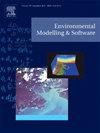Efficient and fine-grained viewshed analysis in a three-dimensional urban complex environment
IF 4.8
2区 环境科学与生态学
Q1 COMPUTER SCIENCE, INTERDISCIPLINARY APPLICATIONS
引用次数: 0
Abstract
Performing efficient and fine-grained viewshed analysis in 3D complex urban models, particularly when handling large-scale datasets, presents a significant challenge in Geographic Information Systems (GIS). Existing methods are primarily designed for 2.5D raster models and struggle to effectively manage large-scale data. Furthermore, the commonly utilized approaches for 3D models need large display memory and lack statistical analyses. To address these challenges, this paper adopted a results-oriented approach that diverged from the traditional data-driven paradigm by reformulating the conventional viewshed computation problem as a spatial query problem. Building on this premise, we proposed the Q-View method for oblique photogrammetry data, which involved creating an indexing model for large-scale datasets and enabled parallel querying between the line-of-sight (LOS) and the model. The Q-View method enables efficient and spatially exhaustive analysis, effectively overcoming the complexities associated with traditional viewshed computations. Experimental results showed that our approach achieved a query rate of up to 4 million visibility queries per second on a dataset with 17.6 million triangular meshes. Compared to the latest methods, it offered a 72.45% improvement in operational efficiency and superior accuracy relative to the GPU-rated method. These findings indicated that the proposed method substantially improved both the accuracy and efficiency of viewshed analysis in complex urban environments, providing decision support for urban planning and environmental monitoring.
三维城市复杂环境的高效细粒度视角分析
在复杂的三维城市模型中执行高效和细粒度的视图分析,特别是在处理大规模数据集时,对地理信息系统(GIS)提出了重大挑战。现有的方法主要是为2.5D栅格模型设计的,很难有效地管理大规模数据。此外,常用的3D建模方法需要较大的显示内存,并且缺乏统计分析。为了应对这些挑战,本文采用了一种以结果为导向的方法,该方法与传统的数据驱动范式不同,将传统的视点计算问题重新表述为空间查询问题。在此前提下,我们提出了针对倾斜摄影测量数据的Q-View方法,该方法涉及为大规模数据集创建索引模型,并在视距(LOS)和模型之间实现并行查询。Q-View方法实现了高效和空间详尽的分析,有效地克服了与传统视图计算相关的复杂性。实验结果表明,我们的方法在1760万个三角形网格的数据集上实现了高达每秒400万次可见性查询的查询率。与最新的方法相比,它提供了72.45%的操作效率提高,相对于gpu额定的方法精度更高。研究结果表明,该方法显著提高了复杂城市环境下视角分析的准确性和效率,为城市规划和环境监测提供决策支持。
本文章由计算机程序翻译,如有差异,请以英文原文为准。
求助全文
约1分钟内获得全文
求助全文
来源期刊

Environmental Modelling & Software
工程技术-工程:环境
CiteScore
9.30
自引率
8.20%
发文量
241
审稿时长
60 days
期刊介绍:
Environmental Modelling & Software publishes contributions, in the form of research articles, reviews and short communications, on recent advances in environmental modelling and/or software. The aim is to improve our capacity to represent, understand, predict or manage the behaviour of environmental systems at all practical scales, and to communicate those improvements to a wide scientific and professional audience.
 求助内容:
求助内容: 应助结果提醒方式:
应助结果提醒方式:


